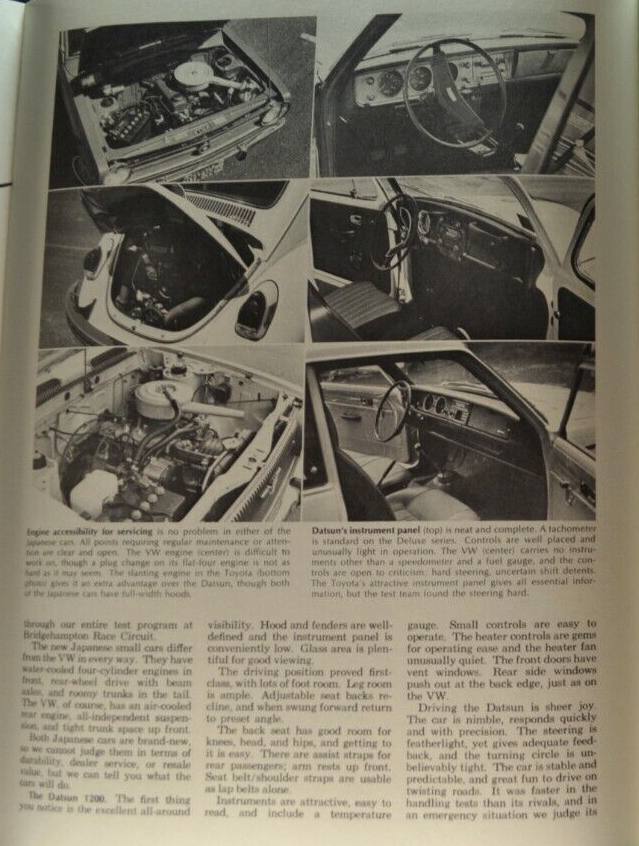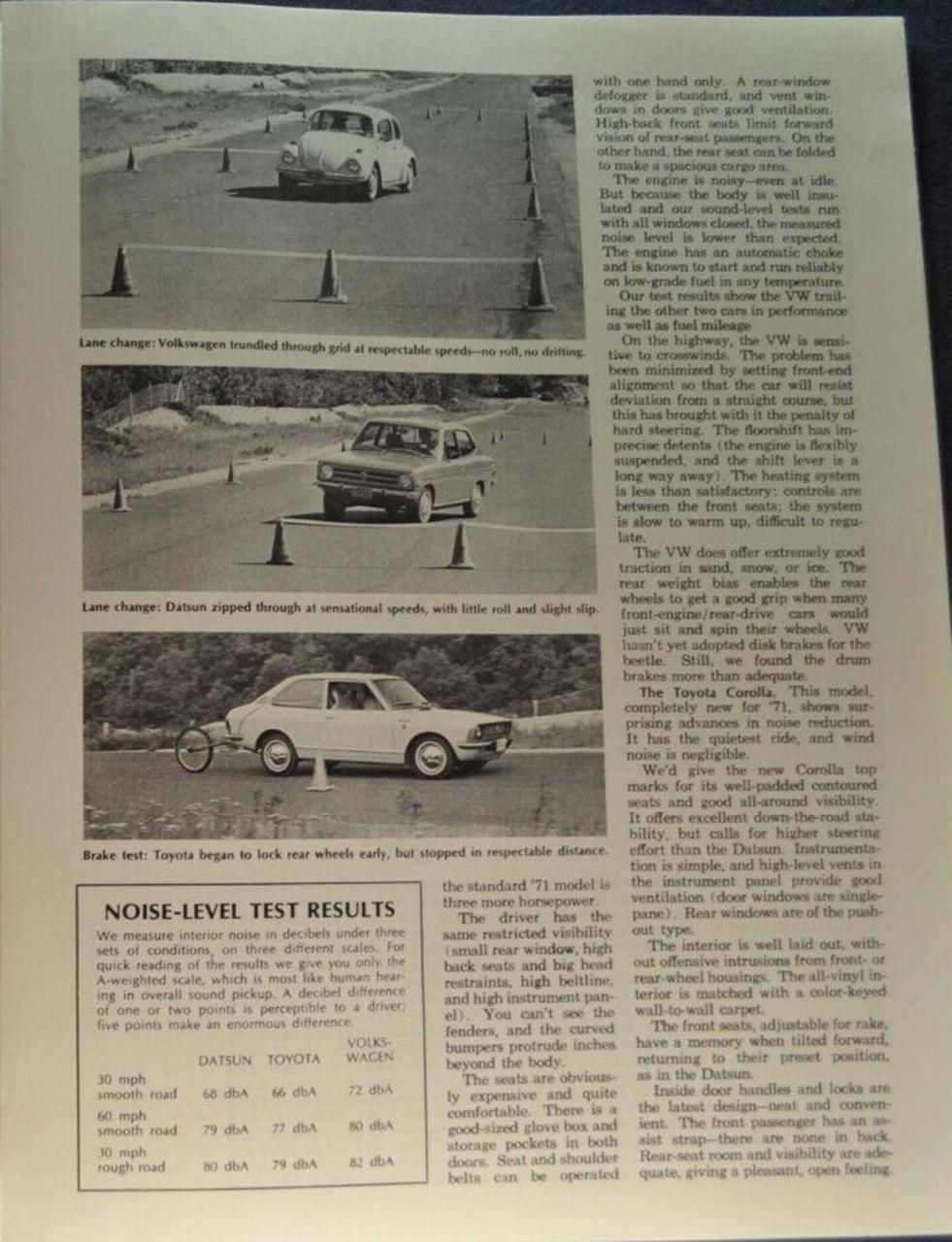Popular Science magazine December 1970, pages 32,34-40
Popular Science Car Test:I need only seconds to make up my mind on this one. Give me the Datsun.
Contents |
Brochure version
Datsun dealer handout. Reprinted article.
<-- back to USA brochures
Title: Popular Science CAR TEST [style seal CAR TEST]
1971 Norbye/Dunne Report B110
Format:1 page tri-fold (6 panels) Size:8.5 x 11" Publication Number:unspecified
Comments? Questions? More photos or info? Reply to main forum: POST Brochures wanted
Sheet Outside panel 1 folded over the inside panel 5

Cover
Reprinted from the December 1970 issue of Popular Science
[dealer stamp] ELDON VORIES MOTORSᴳ 207 South North - 1A 9-4450 Walla Walla, Washington
(C) 1970 Popular Science Publishing Co.
Panel 4
VW's dominance is under attack...by domestic minicompacts, other imports, and now, these Japanese models
By JAN P. NORBYE / PS Automotive Editor
and JIM DUNNE / PS Detroit Editor
PHOTOS BY DAVE HOUSER

Datsun 1200 has clever, moderate styling to disguise a boxy shape that gives exceptional space utilization.
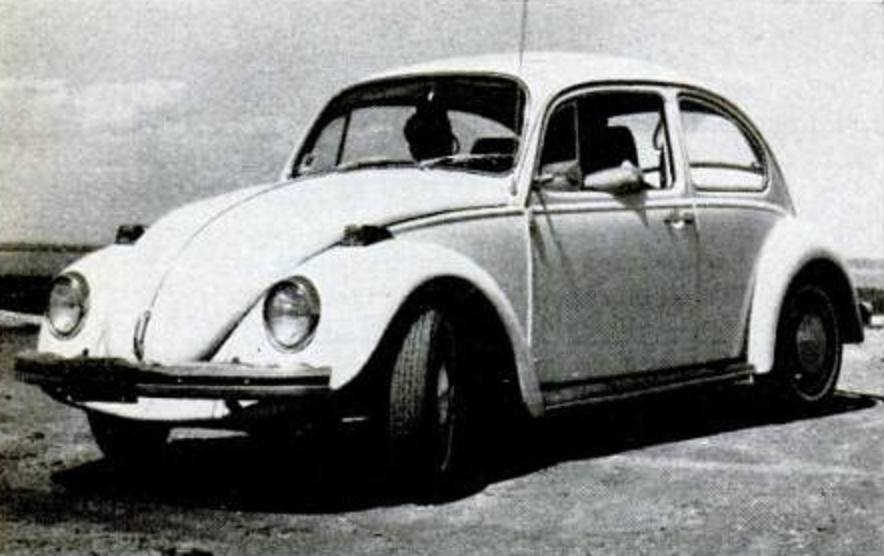
The Volkswagenᵂ, due to its configuration, provides the least usable space inside. This car also had the highest noise levels.

The Toyota Corolla resembles the Datsun in its general architecture, has similar useful space, and offers the quietest ride.
For or about 15 years, the accepted standard for small economy cars has been the VW, affectionately known as "the beetle." It's never been the lowest-priced car on the market. It's never been said to give exceptional gas mileage. Those are not its strong points. Its strong points are the quality of its materials and construction, the availability of parts and service everywhere across the nation, plus its remarkable resale value. That's what has made the VW the number-one small economy car in the U.S.
The beetle has been attacked from above (in price) by Ford and GM (first Cortina and Opel, now Pinto and Vega), by Toyota and Datsun, and by several independent European makers. But it's still the top import, leading the runner-up by a three-to-one margin. Now, something new is happening. The VW is being attacked by cars in its own price range—and under! What's more, these new small cars from Japan pose a real threat to the VW in all areas. We tested them, driving hundreds of miles on the highway and in the city, and putting them
Panel 5

Engine accessibility for servicing is no problem in either of the Japanese cars. All points requiring regular maintenance or attention are clear and open.
The VW engine (center) is difficult to work on, though a plug change on its flat-four engine is not as hard as it may seem.
The slanting engine in the Toyota (bottom center) gives it an extra advantage over the Datsun, though both of the Japanese cars have full-width hoods.

Datsun's instrument panel (top) is neat and complete. A tachometer is standard on the Deluxe series. Controls are well placed and unusually light in operation.
The VW (center) carries no instruments other than a speedometer and a fuel gauge, and the controls are open to criticism: hard steering, uncertain shift detents.
The Toyota's attractive instrument panel gives all essential information, but the test team found the steering hard.
through our entire test program at Bridgehampton Race Circuit. The new Japanese small cars differ from the VW in every way. They have water-cooled four-cylinder engines in front, rear-wheel drive with beam sales, and roomy trunks in the tail. The VW, of course, has an air-cooled rear engine, all-independent suspension, and tight trunk space up front.
Both Japanese cars are brand-new, so we cannot judge them in terms of durability, dealer service, or resale value, but we can tell you what the cars will do.
The Datsun 1200. The first thing you notice is the excellent all-around visibility. Hood and fenders are well-defined and the instrument panel is conveniently low. Glass area is plentiful for good viewing.
The driving position proved first class, with lots of foot room. Leg room is ample. Adjustable seat backs recline, and when swung forward return to preset angle.
The back seat has good room for knees, head, and hips, and getting to it is easy. There are assist straps for rear passengers; arm rests up front. Seat belt/shoulder straps are usable as lap belts alone.
Instruments are attractive, easy to read, and include a temperature gauge. Small controls are easy to operate. The heater controls are gems for operating ease and the heater fan unusually quiet. The front doors have vent windows. Rear side windows push out at the back edge, just as on the VW.
Driving the Datsun is sheer joy. The car is nimble, responds quickly and with precision. The steering is featherlight, yet gives adequate feedback, and the turning circle is unbelievably tight. The car is stable and predictable, and great fun to drive on twisting roads. It was faster in the handling tests than its rivals, and in an emergency situation we judge its
Panel 6
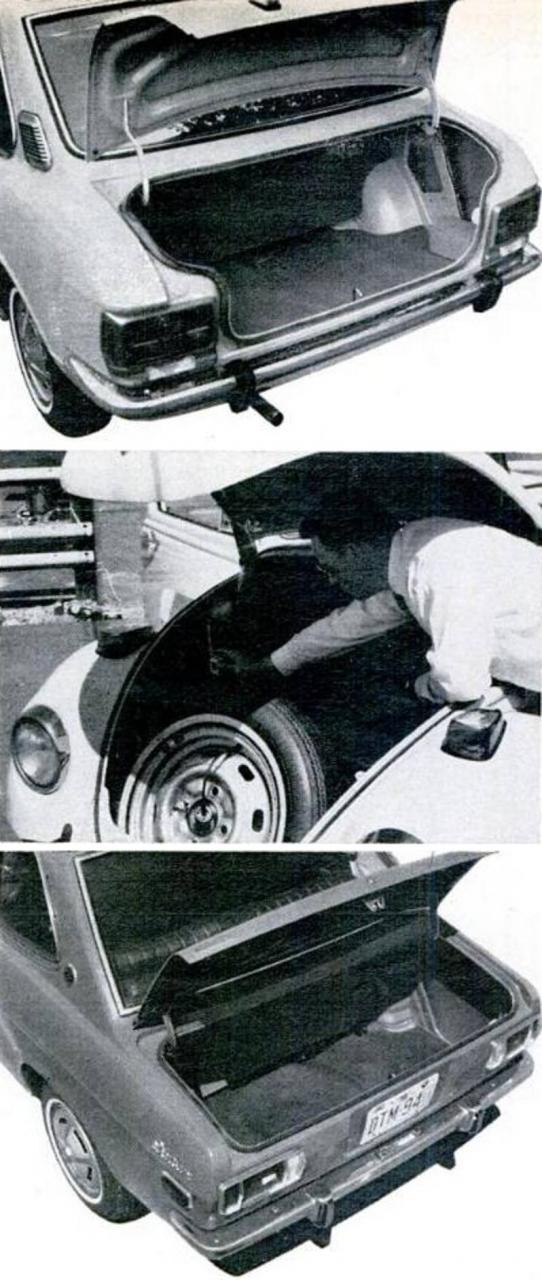
Trunk of the Toyota is capable of holding with ease one large suitcase, a medium one, and a flight bag. And liftover on this car is a mere 20.5 inches!
Intruding wheel wells and droop-hood styling cut into the VW's storage space. The scuttle-mounted fuel tank and spare wheel position also take up room in the front.
The Datsun's trunk is the biggest: 50 inches wide and 24 long with an average height of 36 inches. A low liftover height was sacrificed to gain structural stiffness in the body shell.
handling characteristics to be on a par with the best of European cars, such as the Simca and the Fiat (PS, Nov.). Its rides quietly at all speeds, but the suspension can get harsh on rough roads.
The little engine delivers its modest power so quietly and smoothly that you might think it's a 1600, not a 1200. The engine has a strong pull at low revs, yet is unusually high revving. It's coupled to a clutch with a clean, swift action and a four-speed transmission with fast, light shifts. The brakes proved pleasant and reliable, giving smooth, short stops, with minimal nose dive and no loss of stability.
Fuel economy was the best we've ever had on any car that went through our full test program, and that includes such cars as the Simca 1000 (1118) and Opel Kadett. The engine is readily accessibi le—no possible problem about any plugs, or even the oil filter. Do-it-yourselfers will get itchy hands when they gaze under the hood of this new Datsun.
The trunk is roomy and clear, with normal liftover height.
The Volkswagen. You know what the Volkswagen is like. You probably were at the wheel of one not too long ago, or had a ride in one. Is there anything new to say about it? Yes, but not much. The car we tested was 1970 (the '71 was not yet available), but the only engineering change in
Panel 1
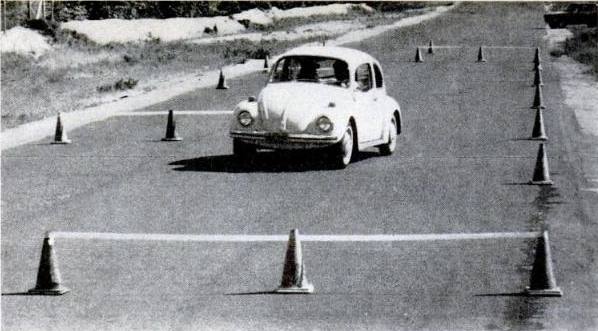
Lane change: Volkswagen trundled through grid at respectable speeds-no roll, no drifting.
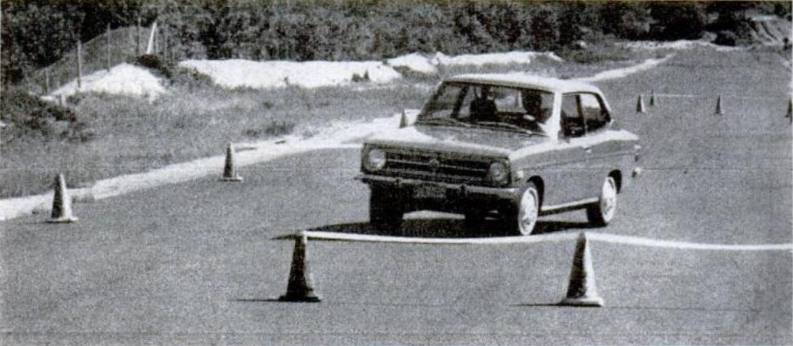
Lane change: Datsun zipped through at sensational speeds, with little roll and slight slip.
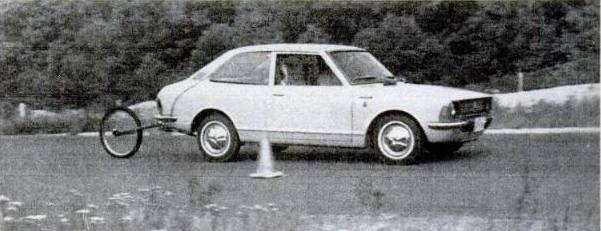
Brake test: Toyota began to lock rear wheels early, but stopped in respectable distance.
the standard 71 model is three more horsepower.
The driver has the same restricted visibility (small rear window, high back seats and big head restraints, high beltline, and high instrument panel). You can't see the fenders, and the curved bumpers protrude inches beyond the body.
The seats are obviously expensive and quite comfortable. There is a good-sized glove box and storage pockets in both doors. Seat and shoulder belts can be operated with one hand only. A rear window defogger in standard, and vent windows in doors give good ventilation. High-back front seats limit forward vision of rear-seat passengers. On the other hand, the rear seat can be be folded to make a spacious cargo area.
The engine is noisy—even at idle. But because the body is well insulated and our sound-level tests run with all windows closed, the measured noise level is lower than expected. The engine has an automatic choke and is known to start and run reliably on low-grade fuel in any temperature.
Our test results show the VW trailing the other two cars in performance us well as fuel mileage.
On the highway, the VW is sensitive to crosswinds. The problem has been minimized by setting front-end alignment so that the car will resist deviation from a straight course, but this has brought with it the penalty of hard steering. The floorshift has imprecise detents (the engine is flexibly suspended, and the shift lever is a long way away). The heating system is less than satisfactory: controls are between the front seats; the system is slow to warm up, difficult to regulate.
The VW does offer extremely good traction in sand, snow, or ice. The rear weight bias enables the rear wheels to get a good grip when many front-engine/rear-drive cars would just sit and spin their wheels. VW hasn't yet adopted disk brakes for the beetle. Still, we found the drum brakes more than adequate.
The Toyota Corolla. This model, completely new for '71, shows surprising advances in noise reduction. It has the quietest ride, and wind noise is negligible.
We'd give the new Corolla top marks for its well-padded contoured seats and good all-around visibility. It offers excellent down-the-road stability, but calls for higher steering effort than the Datsun. Instrumentation is simple, and high-level vents in the instrument panel provide good ventilation (door windows are single-pane). Rear windows are of the push-out type. The interior is well laid out, without offensive intrusions from front- or rear-wheel housings. The all-vinyl interior is matched with a color-keyed wall to wall carpet.
The front seats, adjustable for rake, have a memory when tilted forward, returning to their preset position, as in the Datsun.
Inside door handles and locks are the latest design—neat and convenient. The front passenger has an assist strap—there are none in back. Rear seat room and visibility are adequate, giving a pleasant, open feeling
We measure interior noise in decibels under three sets of conditions, on three different scales. For quick reading of the results we give you on the A-weighted scale, which is most like human hearing in overall sound pickup. A decibel difference of one or two points is perceptible to a driver; five points make an enormous difference.
| condition | DATSUN | TOYOTA | VOLKSWAGEN |
|---|---|---|---|
| 30 mph smooth road | 68 dbA | 66 dbA | 72 dbA |
| 60 mph smooth road | 79 dbA | 77 dbA | 80 dbA |
| 30 mph rough road | 80 dBA | 79 dbA | 82 dbA |
Panel 2

Looking them over from left to right: Volkswagen 1600, Datsun 1200, and Toyota Corolla.
The back seat has storage bins on either side. In front, there's a shelf in addition to the glove box. The trunk is roomy and very practical in shape, with bumper-level liftover height, which makes loading easier.
The quiet little engine pulled very strongly throughout its speed range, and almost matched the Datsun on acceleration. Engine accessibility is exceptional—it's one of the easiest-to-work-on engines we've ever seen. The block slants to the left, and the plugs are in the open, coil and distributor are in full view, and even the oil filter stands free, accessible from above.
The brakes proved to be somewhat below average for such a light car, giving rear wheel-locking problems even during the warmup stops.
But the handling characteristics of the new Corolla are disappointing. Body roll in hard turns seems exaggerated, and the inside rear wheel begins to lift under very low lateral forces. The car showed stability problems when going through our handling tests—both the high-speed lane change and the low-speed traffic weave. This car requires caution in maneuvering, even at quite low speeds, and could be unsafe in an emergency situation.
Conclusions
Norbye: I need only seconds to make up my mind on this one. Give me the Datsun. The joy of driving it, plus its overall practicality and complete lack of design flaws, add up to a package of fantastic value when you look at its sticker price.
Dunne: The Datsun is my choice, too. The car is safe, stable, economical, quiet, refined, and great fun to drive. Yet it has adequate seating for four and enough carrying capacity for all normal needs.
Testing and Results
How PS tests cars—and what the tests show
Brake test shows a car's ability to stop on a straight line from 60 mph, without locking any wheels, after 10 stops from 60 at one-minute intervals with 1/2g deceleration (normal quick stop). Final stop is made in a 12-foot wide lane and stopping distance is measured. Excessive pedal pressure indicates fading brakes. Excessive distance indicates fade, locking, or both.
Acceleration test at 0-60 mph shows a car's ability to reach cruising speed from standstill. The 0-80 mph test shows its high-speed power reserve; 25-70 mph test simulates a highway merging situation. Cars with automatic transmission are tested in DRIVE.
[image: lane weave]
Two lane changes in quick succession show a car's ability to make an emergency maneuver at speed. Lanes are blocked 120 feet apart, and lane-change gaps are 60 feet long. Each car is put through test at increasing speed until its maximum is established.
[image: lane slalom]
Low-speed emergency maneuver test means sneaking a car as fast as possible through pylons 48 feet apart. In both handling tests, times clocked by two stopwatches are converted to mph.
| DIMENSIONS | DATSUN | TOYOTA | VW |
|---|---|---|---|
| (inches) | 1200 | Corolla | 1600 |
| A1 Ground clearance | 6.7 | 6.7 | 5.9 |
| A2 Front leg room (max.) | 42.0 | 42.0 | 42.5 |
| A3 Front head room | 36.0 | 36.0 | 37.5 |
| A4 Rear head room | 33.25 | 33.5 | 32.0 |
| A5 Rear leg room (min.) | 33.5 | 32.0 | 37.5 |
| A6 Wheelbase | 90.6 | 90.0 | 94.5 |
| A7 Height | 54.7 | 54.3 | 59.1 |
| B1 Width | 58.9 | 58.5 | 61.0 |
| B2 Length | 152.6 | 152.8 | 158.7 |
| B3 Front track | 48.8 | 49.0 | 51.6 |
| B4 Rear track | 49.0 | 48.0 | 53.3 |
| B5 Front hip room | 45.5 | 46.0 | 43.0 |
| B6 Rear hip room | 41.0 | 44.0 | 51.5 |
| SPECIFICATIONS | Datsun | Toyota | VW |
| Engine type | OHV 4-in-line | OHV 4-in-line | OHV flat-4 |
| Bore x stroke | 2.87x2.76 in. | 2.95x2.60 in. | 3.36x2.72 in. |
| Displacement | 71.5 cu. in. | 71.1 cu in | 96.66 cu in. |
| Compression ratio | 9.0:1 | 9.0:1 | 7.5:1 |
| Carburetion | One 2-barrel | One 2-barrel | One 1-barrel |
| Power @ rpm | 69 @ 6,000 | 73 @ 6,000 | 57 @ 4,400 |
| Torque (lb-ft) @ rpm | 70.1 @ 3,600 | 74.2 3,800 | 81.7 @ 3,000 |
| Transmission | 4-speed manual | 4-speed manual | 4-speed manual |
| Axle ratio | 3.90:1 | 4.222:1 | 4.125:1 |
| Tires | Bridgestone Skyway | Dunlop Gold Seal | Continental |
| Tire size | 6.00-12 | 6.00-12 | 5.60-15 |
| Turning diameter | 26.9 ft. | 30 ft. | 36 ft |
| Turns lock to lock | 3.4 | 3.5 | 2.75 |
| Brakes | Disk/drum | Drum/drum | Drum/drum |
| Fuel tank | 10.6 gal | 9.5 gal | 10.6 gal. |
| Curb weight | 1,587 lbs. | 1,566 lbs. | 1,808 lbs. |
| TEST RESULTS | Datsun | Toyota | VW |
| Acceleration 0-60 mph | 18.4 sec. | 18.6 sec. | 22.6 sec. |
| Acceleration 0-80 mph | 37.0 sec | 37.8 sec. | 45.0 sec. |
| Acceleration 25-70 mph | 21.0 sec | 22.0 sec. | 28.5 sec. |
| Braking distance 60-0 mph | 159 ft. 4 in. | 167 ft. 8 in. | 155 ft. 3 in. |
| Brake pedal pressure | 120 lbs | 120 lbs. | 115 lbs. |
| Max speed—lane change | 53.0 mph | 49.8 mph | 52.2 mph |
| Max speed—traffic weave | 26.6 mph | 24.2 mph | 26.2 mph |
| Average fuel mileage | 28.0 mpg | 26.0 mpg | 21.2 mpg |
| Price (basic) | $1,736 | $1,798 | $1,839 |
| Price (as tested) | $1.888 | $1,798 | $1.992 |
Super Beetle
Here's the Super Beetleᴳ

Since this test was made, Volkswagen has introduced two versions of the beetle for 1971: the Super Beetle and the Custom Beetle. The Super Beetle (shown above has a new front suspension system that takes up less space, providing somewhat larger trunk space under the hood. The Custom Beetle is identical to the VW that we tested, except for more spartan trim and three more horsepower. The Super Beetle costs $60 more than the '70 VW, the Custom $59 less.

![[Datsun 1200 encyclopedia]](/wiki/upload/wiki.png)


